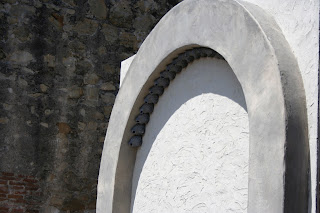When the swallows come back to Capistrano.
(Have you heard that song?)
The swallows migrate to San Juan Capistrano every year in March. John O' Sullivan (who came to the Mission in 1910, and was the first priest in 24 years. That guy.) wrote this story about the swallows in his book Capistrano Nights: Tales of a Mission Town:
“I was passing the new hotel at the west side of the town plaza, and there was the proprietor out with a long pole smashing the swallows’ nest that were under the eaves. The poor birds were in a terrible panic, darting hither and thither flying and screaming about their demolished homes.
“What in the world are you doing,” I asked.
“Why,” said he, “these dirty birds are a nuisance, and I am getting rid of them.”
“But where can they go?” I continued.
“I don’t know and I don’t care,” He replied slashing away with his pole, “but they’ve no business here, destroying my property.”
“Then come on swallows,” I cried, “I’ll give you shelter. Come to the Mission, there is room enough there for all.”
“Sure enough they all took me at my word, and the very next morning they were busy building under the newly built sacristy of Father Serra’s church." I found this at missionsjc.com.
Now, people are trying to coax the spirited birds back to the Mission,
with recorded mating calls, and plaster nests (those are in the photo below.)
Come back little guys!!
The swallows do return to the town every year, and there is a big celebration with dancing,
children in bight bird costumes, and songs.
A statue of Father Serra, who founded the Mission, and a young Indian boy.
We went into the Serra Chapel, which is in the Mission and still used today. There are so many beautiful artifacts that had been in that same church hundreds of years ago. We saw lots of paintings that had been so carefully excavated and restored. It sounded like a lot of work.
What Ellie is looking at in the picture above, is the huge altar in the back of the church. This giant masterpiece made of wood and overlaid with gold, is about 400 years old. I think a conservation lady wanted to decorate the church with something historical, and a man who worked in the church let her look around in the attic. There, she found the altar. In hundreds of pieces, in tons of boxes.
They removed a layer of paint someone had put on the altar so that it would be original. Even though people said they should patch it up to make it look newer. What would be the point of making a historical artifact look brand new??
On the audio tour, a man said he remembered sitting in the pews when he was younger, watching curious chickens stroll inside, and someone's peacock strut in and flap among the pews! Now that would be a fun service!
Here are a couple cool clips from around the Mission.
I just loved these walkways.
Merchants would dump their trash when they came to the coast to trade.
Probably a Capistrano local found this wood, and decided to make it a shelf.
But, what's with the circular grooves? This shelf used to be a cannon ball rack on a ship!!
That is the original roofing!!
And now to finish part two, some thoughts on cooking.
This lovely oven is part of the kitchen where your food would be cooked if you lived in the Mission.
Outside in the baking heat. While you were baking. Ouch.
And if you were one of the cooks in 1801, you'd have to cook for 1,000 people! But only three times a day. Heh.
(I'm guessing that these cooking people were pretty strong characters... or didn't have nerves...)
😅










































